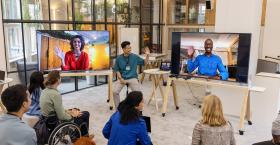Culture & Onboarding: Connecting Your Remote & Hybrid Employees
Author

Here are some of the things that I used to worry about when starting a new job:
- Am I dressed appropriately?
- Will I have to eat lunch at my desk by myself?
- What if I can’t get my computer to work? Will people assume I’m stupid?
- Who will I be friends with? Who should I avoid?
- Is it okay to ask questions or should I try to find out stuff myself?
- What time does everyone leave for the day?
- What if no one talks to me?
Now that I’m working completely remotely, I have a whole different set of questions.
- Do I need to be on video for calls or is just audio okay? Should I dress up for them (at least my top half)?
- How often should I touch base with my boss? Do I need to prove that I’m working all day?
- Who will know the answers to my questions about lunch breaks, email etiquette, holidays, etc.?
- How do I make friends if everyone is remote? Who should I trust?
- How can I tell if people like me, if I’m a good fit for this organization?
These kinds of questions really address the culture of an organization. And by culture, I mean how things are done. They can range from how you format your emails to what hours you work to how you show up in meetings to who gets promotions.
How do you figure these things out without being in person?
Guess what? It’s not your sole responsibility to figure these things out. Any organization that has remote employees owes it to them to address culture in their onboarding. I’m not talking about sharing vision and values and behaviors. I’m talking about giving context and clarity about the culture to new employees and sharing things like how people succeed, who gets promoted and who doesn’t, how teams work and what are the unwritten rules for them, how much autonomy you can expect, and the list goes on.
Jamie Kohn, research director for the HR practice at Gartner says that, “Employees today are experiencing a crisis of connection, and HR leaders report that the biggest challenge with expanding remote work is maintaining the organization’s culture. Traditionally, new hires are connected to organizational culture organically by living it in their day-to-day, in-person interactions. For many people working remotely, changing companies can feel like swapping out one laptop for another.”
If you want to make onboarding easier for employees and help them to connect to your organization, you need to discuss those things that everyone wants to know. Does your CEO command a rigid hierarchy or is he/she interested in talking to employees? What if a big project fails? Can people fail forward or is it cause for termination? Do managers try to catch employees doing something right or something wrong? Who should be included in meetings?
Covering this kind of information in onboarding may seem frivolous or even gossip-y at times. Before remote work, people had ample opportunity to discover these things on their own. Now, if we want people to connect and become part of our culture, we have to tell them what to expect and what is expected of them. That transparency then becomes part of the culture, which benefits everyone.
Author

Explore our Onboarding Virtual Workshop
Learn more about how you can optimize your onboarding with agile techniques by attending our new Onboarding Your Hybrid & Remote Workforce Virtual Workshop or our Hybrid & Remote Workforce: The Future of Productivity Virtual Conference.

